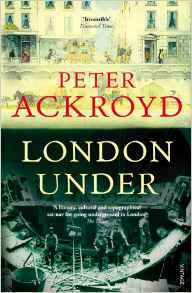 The first chapter of Peter Ackroyd’s London Under is entitled Darkness Visible and it begins ‘Tread carefully over the pavements of London for you are treading on skin, a skein of stone that covers rivers and labyrinths, tunnels and chambers, streams and caverns, pipes and cables, springs and passages, crypts and sewers, creeping things that will never see the light of day.’
The first chapter of Peter Ackroyd’s London Under is entitled Darkness Visible and it begins ‘Tread carefully over the pavements of London for you are treading on skin, a skein of stone that covers rivers and labyrinths, tunnels and chambers, streams and caverns, pipes and cables, springs and passages, crypts and sewers, creeping things that will never see the light of day.’
I read this book when it was first published (Chatto and Windus, 2011) but have re-read it recently, in conjunction with London Overground: A Walk Around the Ginger Line by Iain Sinclair (Penguin, 2015).
With his customary erudition and comprehensive knowledge of the city, even before it was a city, Ackroyd explores what lies beneath, from the Palaeozoic to the present day. He takes most delight, it seems to this reader, in how the London of one time reappears and impacts upon the London of another time. One stratum intrudes upon another – Roman London, Saxon London, explosions of ‘coal gas’ ( a euphemism for the sulphurated hydrogen produced by the decomposition of excrement ) in Mayfair and St. James’.
The sewers feature, as do the subterranean canals and the tunnelling pipes 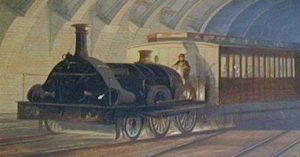 which carry water, gas, electricity, as well as the river tunnels (there are over twenty, more than in any other comparable city in the world, though I couldn’t name more than about ten). He chronicles the development of the London Underground from the first proposals by Charles Pearson, founder of the Metropolitan Railway Company, in the 1830s. I was rather taken by an alternative proposition by Sir Joseph Paxton, he of Crystal Palace fame, for an elevated railway above the streets, lined by glass.
which carry water, gas, electricity, as well as the river tunnels (there are over twenty, more than in any other comparable city in the world, though I couldn’t name more than about ten). He chronicles the development of the London Underground from the first proposals by Charles Pearson, founder of the Metropolitan Railway Company, in the 1830s. I was rather taken by an alternative proposition by Sir Joseph Paxton, he of Crystal Palace fame, for an elevated railway above the streets, lined by glass.
 One could write an entire book about London Underground, (some have), its abandoned tunnels and ‘dead stations’ like that at Aldwych, which I passed everyday on my way to work, or the station near Hyde Park Corner, now (see left) part of an hotel. Ackroyd can only skim the surface.
One could write an entire book about London Underground, (some have), its abandoned tunnels and ‘dead stations’ like that at Aldwych, which I passed everyday on my way to work, or the station near Hyde Park Corner, now (see left) part of an hotel. Ackroyd can only skim the surface.
He is very good on how the tunnels beneath the surface mirror the world above. Like the LU tunnels beneath the City of London, which all follow the mediaeval street pattern so as to minimise the risk of damage to ancient, built-over buildings. Many of London’s squares and open spaces cover underground refuges and trenches. Lincoln’s Inn Fields is set atop a network of tunnels 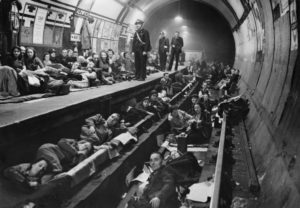 designed to hold 1,300 people and there are the ‘deep’ LU stations like those at Clapham. These acted as shelters in WWII, but were also home to new arrivals from the Commonwealth on ships like the Windrush post War. What on earth these folk thought of the place they had come to, leaving the sunshine of the Caribbean, to be housed deep beneath the earth, one can only speculate. Incidentally, the nearest Labour Exchange (Job Centre) to Clapham was in Brixton. Thus ‘Black Brixton’ was born.
designed to hold 1,300 people and there are the ‘deep’ LU stations like those at Clapham. These acted as shelters in WWII, but were also home to new arrivals from the Commonwealth on ships like the Windrush post War. What on earth these folk thought of the place they had come to, leaving the sunshine of the Caribbean, to be housed deep beneath the earth, one can only speculate. Incidentally, the nearest Labour Exchange (Job Centre) to Clapham was in Brixton. Thus ‘Black Brixton’ was born.
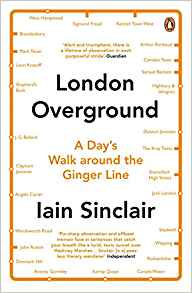 Ackroyd is also good on the literature and mythology of place. As is Iain Sinclair, whose walk around the ‘Ginger Line’ is the ostensible subject of his book. It is about the London of this topaz necklace in the same way as his London Orbital is about the M25, as a prompt to further thought, a jumping off point to explore the places through which it passes, their present and past.
Ackroyd is also good on the literature and mythology of place. As is Iain Sinclair, whose walk around the ‘Ginger Line’ is the ostensible subject of his book. It is about the London of this topaz necklace in the same way as his London Orbital is about the M25, as a prompt to further thought, a jumping off point to explore the places through which it passes, their present and past.
Sinclair uses his experiences in the present, as he passes through the parts of London where the Ginger Line runs, to illuminate the changing city. His journey is, he acknowledges, bound up with writers and artists of all kinds, most obviously Angela Carter in SW London and Leon Kossoff in NW London,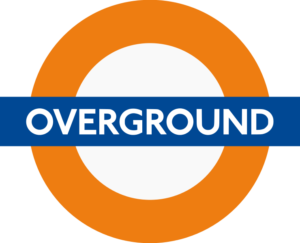 Michael Moorcroft and others across the capital. London Overground is personal in a way that London Under is not, although Ackroyd’s fascination with the city permeates his many writings. The Ackroyd is a book about London; the Sinclair is a book about his journey through contemporary London, therefore it has a greater immediacy.
Michael Moorcroft and others across the capital. London Overground is personal in a way that London Under is not, although Ackroyd’s fascination with the city permeates his many writings. The Ackroyd is a book about London; the Sinclair is a book about his journey through contemporary London, therefore it has a greater immediacy.
Both write poetically, though Sinclair’s language has more pyrotechnics. Both have an eye for the bizarre, but Sinclair’s setting has a sense of danger, real and modern, while Ackroyd summons the numinous and haunting past. I learned more about London, the entity, from Ackroyd, I learned more about living in London from Sinclair.
I enjoyed both hugely and can recommend them both.
If you enjoyed reading this review you might also enjoy Novels Historical Short Stories Another Child’s Eye Landscape


 RSS – Posts
RSS – Posts
2 responses to “London Books”